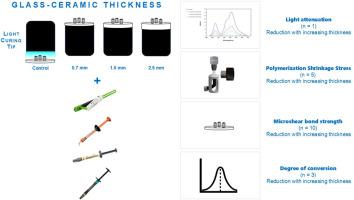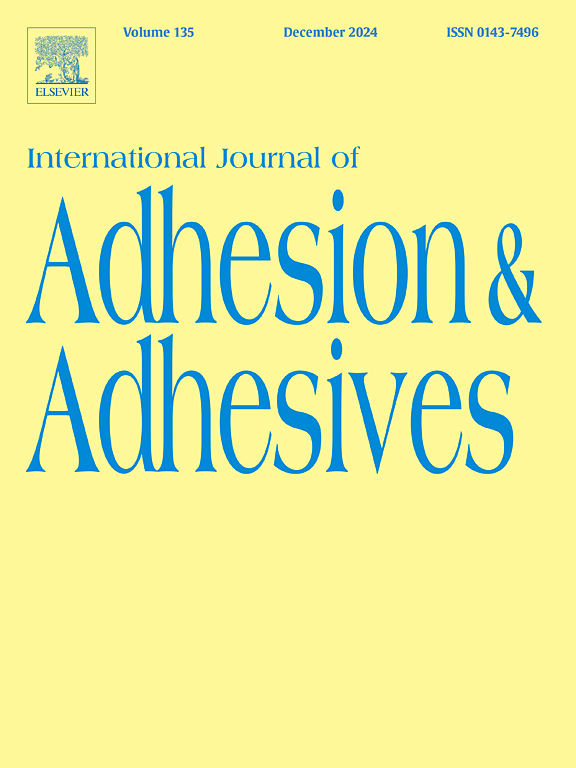玻璃陶瓷厚度对树脂水门汀的转化程度、聚合收缩应力和粘接强度的影响
IF 3.2
3区 材料科学
Q2 ENGINEERING, CHEMICAL
International Journal of Adhesion and Adhesives
Pub Date : 2024-11-02
DOI:10.1016/j.ijadhadh.2024.103871
引用次数: 0
摘要
本研究旨在评估陶瓷盘厚度对双固化(RelyX Universal 和 RelyX Ultimate)和光固化(Variolink N LC 和 Variolink Esthetic LC)树脂水门汀的光衰减、转换度 (DC)、聚合收缩应力 (PSS) 和微剪切粘接强度 (μSBS)的影响。使用二硅酸锂玻璃陶瓷制作了 40 个陶瓷盘,厚度分别为 0.7、1.5 和 2.5 毫米。在进行 μSBS 测试(n = 10)时,通过内径为 0.7 毫米的泰尔贡管将树脂水泥棒粘结到陶瓷盘上,然后在 37 °C 的水中浸泡 24 小时后进行测试。在 PSS 测试中(n = 5),玻璃棒对准 1 毫米的间隙,用树脂水泥填满,然后光固化,用软件测量位移。光衰减分析(n = 1)包括在光固化装置顶端放置圆盘并测量辐射发射率。对于直流测试(n = 3),ATR-傅立叶变换红外光谱仪通过每个陶瓷圆盘测量光固化试样。数据分析采用双向方差分析和 Tukey 检验(α = 0.05)。结果表明,1.5 毫米和 2.5 毫米厚的陶瓷明显减弱了透光率,从而降低了所有树脂粘接剂的 μSBS、DC 和 PSS 平均值。在临床上,较厚的陶瓷会降低透光率,这可能会影响树脂水门汀的聚合。对于较厚的修复体来说,双固化水门汀更可取,因为它们能够补偿减少的光线。本文章由计算机程序翻译,如有差异,请以英文原文为准。

Effect of glass-ceramic thickness on the degree of conversion, polymerization shrinkage stress, and bond strength of resin cements
The aim of this study was to evaluate the effect of ceramic disc thicknesses on light attenuation, degree of conversion (DC), polymerization shrinkage stress (PSS), and microshear bond strength (μSBS) of dual-cured (RelyX Universal, and RelyX Ultimate) and light-cured (Variolink N LC, and Variolink Esthetic LC) resin cements. Forty ceramic discs were fabricated using lithium disilicate glass-ceramic in thicknesses of 0.7, 1.5, and 2.5 mm. For the μSBS test (n = 10), resin cement rods were bonded to the ceramic discs through Tygon tubes with 0.7 mm internal diameter and tested after 24 h in water at 37 °C. For the PSS test (n = 5), glass rods were aligned with a 1 mm gap filled with resin cement and light-cured, with displacement measured by software. Light attenuation analyses (n = 1) involved positioning discs at the light-curing unit tip and measuring radiant emittance. For the DC test (n = 3), an ATR-FTIR spectrometer measured light-cured specimens through each ceramic disc. Data were analyzed using two-way ANOVA and the Tukey test (α = 0.05). The results showed that the 1.5- and 2.5-mm thick ceramics significantly attenuated the light transmission and, consequently, reduced the mean values of μSBS, DC, and PSS for all resin cement used. Clinically, thicker ceramics reduce light transmission, which may compromise the polymerization of the resin cement. Dual-cure cements are preferable for thicker restorations because of their ability to compensate for the reduced light.
求助全文
通过发布文献求助,成功后即可免费获取论文全文。
去求助
来源期刊

International Journal of Adhesion and Adhesives
工程技术-材料科学:综合
CiteScore
6.90
自引率
8.80%
发文量
200
审稿时长
8.3 months
期刊介绍:
The International Journal of Adhesion and Adhesives draws together the many aspects of the science and technology of adhesive materials, from fundamental research and development work to industrial applications. Subject areas covered include: interfacial interactions, surface chemistry, methods of testing, accumulation of test data on physical and mechanical properties, environmental effects, new adhesive materials, sealants, design of bonded joints, and manufacturing technology.
 求助内容:
求助内容: 应助结果提醒方式:
应助结果提醒方式:


